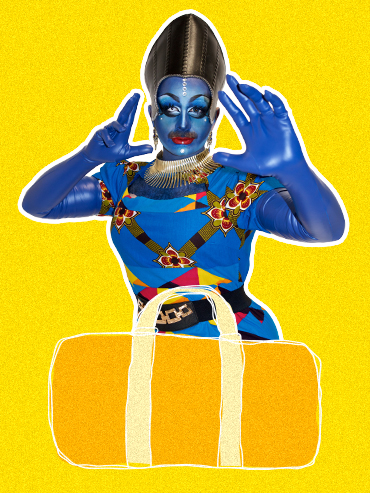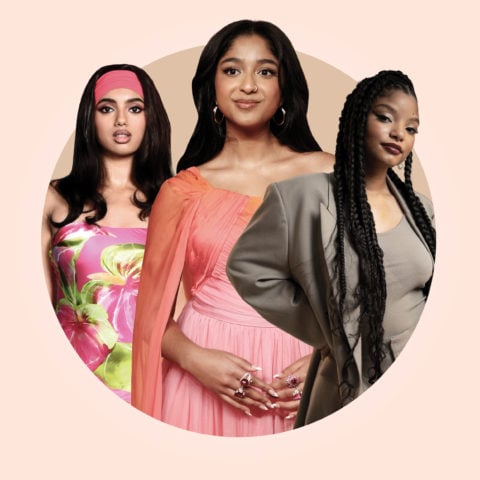“On a *Really* Good Night I’ll Make a Few Hundred Dollars”
FLARE asked nine Toronto drag performers, including Halal Bae, to show us what's in their drag bags. And *then* we got down to real talk about their finances

Drag *looks* expensive, but in reality, being a drag artist is a working class gig. (Unless you’re on RuPaul’s Drag Race, duh.) To find out what it’s really like to try to make it as a queer artist in one of Canada’s expensive cities, FLARE asked nine Toronto drag performers on the rise to show us what’s in their drag bags—and then we got down to real talk about their finances, from tipping culture in Canada to hustling to make rent to shopping for fake boobs.

Drag Name: Halal Bae
Time in drag: 1.5 years
Non-drag job: Project manager
“When I get a drag gig, what I get paid sometimes isn’t enough to cover costs, especially when I have to travel. I live in the east end of Toronto and work in the west end, so when I go to a show, it’s about $15 to take an Uber there. I don’t feel comfortable taking public transit in drag—it’s definitely a safety issue. And it also just takes forever.
It’s definitely very hard trying to make it in Toronto as a queer artist, not only because the city itself is very expensive but also because there are so many amazing queer drag artists in the city. There’s a lot of competition.
When I first started, I didn’t have a rate I asked for. I would do drag for the bare minimum pay. Now my minimum for one song, the base is $100. A lot of work goes into what I do. Even just a pair of tights is $20 and I have to wear three at once. On a really good night I’ll make a few hundred dollars, maybe $200 or $300. That’s a *really* good night. A bad night is more like $80. All of the money I make goes back into my drag. It goes into more makeup, more jewellery, more clothes.
My numbers often involve props and storylines—I create productions, not just dance numbers. It gets expensive but I try to find cheap options. I live right next to the Dollarama and I go there almost every day. During Pride season, I go twice a day.
I also produce my own shows. I have a monthly show called Living In Colour where I book queer POC to perform and DJ. I’m also the producer of Passion Fruit, an all-gender inclusive sex-positive party. It’s stressful to have your money on the line. You have to put up the till, you have to pay every performer. I’m aware of the struggle a lot of performers go through so I always pay them what they’re worth and I try not to give anybody less than $100, even if it’s just one song, because it takes two hours to get into drag and costs money to get there and to make clothes.
A lot of us don’t to take time off for ourselves. It’s a hustle and as a drag performer you want to get as many gigs and possible and do as much as you can. But what we tend to forget is you definitely need to take a day to be yourself and relax at home. I have my dog who keeps my sane and I smoke weed which helps me relax at the end of of the day. Those are things I always make time for and save money for.”

1. Shoes: ”These are from Liz Claiborne. It’s hard to find shoes for me because I’m a women’s size 12. I used to go to Payless but it closed, so now I try to find shoes whenever I go to the states because they tend to have more selection in larger sizes in the U.S.”
2. Hair Glue: “I use Hair Bond as eyelash glue. It’s much stronger than eyelash glue and it’s waterproof. I usually have three glues in my bag: Hair Bond, nail glue and Spirit Gum for my lacefront wigs.”
3. Dress: ”I got this secondhand off another queen, Mona Moore. It’s important to trade. I have two drag daughters I give stuff to and I’ve bought a lot of stuff off other queens. It’s cost-effective. This one Mona didn’t even wear. It didn’t fit her well so I bought it off her and it was really cheap.”
4. Palette: “This is a really nice palette. It’s from Juvias and I like it because the colours are really pigmented. These colours are all inspired by places in Africa. It’s a Black-owned business and they do a lot of really good palettes.”
5. Wig: “I got this wig from New York and it was about $140. I wanted a braided look—I’m North African and you see a lot of hairstyles like this where I come from.”
6. Pads: “These are made out of couch cushions. I go to Walmart and buy a square cushion. I think they cost $7.50 a block, so $15 for a pair. It takes a few hours to make pads—it’s very time consuming. But I can wear my pads for about a year.”
More What’s in Your (Drag) Bag:
Tash Riot: “I Was Raised to Be Careful With Money, but to Be Honest I Don’t Really Think About It”
Manghoe Lassi: “My Career Has Definitely Allowed Me to Be More Extravagant With My Drag”
The Ugly One: “There’s a Lot of Instances Where, if It Wasn’t for the Tip Bucket, I Wouldn’t Have Gotten Paid”
Manny Dingo: “I’m Very Cheap. In a Month I Might Spend $40 or $50 on Makeup”
Archie Maples: “I Make Sure My Bases Are Covered Rent-wise, but It’s All $100 at a Time”
ZacKey Lime: “Drag Kings Don’t Really Get Tips. I Can’t Tell You Why, But It’s a Problem”
Priyanka: “The Way Drag’s Blowing Up Right Now, There’s Definitely Potential to Work Full-Time”
Maris: “I’ve Performed for Free in the Past, but I Try to Stay Away From That Now”








